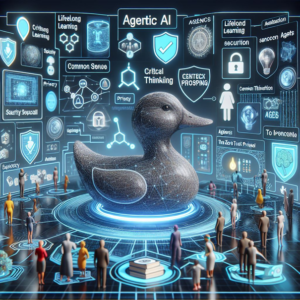In today’s digital era, automation, increased efficiency, data science and artificial intelligence (AI) in general are not just buzzwords, but sometimes decisive factors for the medium/long-term success of companies and organisations worldwide. Despite the hype surrounding AI in particular, it is becoming increasingly clear how AI technologies can be used in general and specifically in an organisation-oriented manner to achieve competitive advantages in the direction of ‘business intelligence’ and even ‘business excellence’. The strategic importance of AI readiness and how companies can increase their efficiency and develop innovative solutions through the use of data science and AI should be defined in every agenda or ICT digital DNA strategy.

Innovation and increased efficiency
Digitalisation offers companies enormous opportunities to innovate and increase efficiency. By using artificial intelligence (AI), processes can be automated and optimised, leading to significant cost savings and improved productivity. However, this also brings challenges, particularly in terms of integrating / adapting new technologies into existing systems / processes and training / empowering employees to use them effectively and optimise them.
Regulation and compliance
With increasing digitalisation and the use of AI, the requirements for regulation and compliance are also increasing. Companies must ensure that they comply with the applicable laws and regulations in order to avoid legal consequences. This includes data protection, data security and compliance with industry standards. The e.g. European General Data Protection Regulation (GDPR) with a Data Protection Impact Assessment (DPIA), Data Processing Agreement (DPA) and AI Act indirectly or the Swiss Data Protection Act are individual examples of such regulation, which presents companies with major challenges and forces them to do older homework.
Cybersecurity / cybercrime in the dynamic threat situation
The threat of cyberattacks is constantly increasing and companies must continuously improve their cybersecurity measures to protect themselves from these dynamic and increasingly AI-enabled threats. This includes technical measures such as cloud & mail security, endpoint protection, firewalls, encryption, compliance policies, monitoring, penetration tests as well as organisational measures such as ICT risk management, business continuity management, incident response management, audits, continuous reporting, training and cybersecurity awareness among employees. Particular attention should be paid to protection against social engineering attacks (e.g. phishing messages), as these represent one of the greatest threats.
Data protection and data security
The protection of personal and company-sensitive data is a key issue in the digital world.Companies must ensure that they store and process the data of their customers, company and employees securely. This requires not only technical measures / enforcement policies, but also clear guidelines and processes to ensure data protection and constantly adapt to the dynamic threat situation. The introduction of basic principles such as ‘Privacy / Security by Design’ and ‘Privacy / Security by Default’ are important approaches for integrating data protection / data security into the expansion / development / migration of systems and processes right from the start.
If further homework is added on an ongoing basis and this becomes even more complex and dynamic in addition to ‘daily business’, a correspondingly precise and ongoing analysis is required as part of an ICT strategy and the ICT project portfolio management derived from this.
AI readiness, but first of all optimisation and automation readiness
Preparation for the use of AI, also known as AI readiness, is a decisive factor for success in the digital transformation. Companies must ensure that they have the necessary resources and competences to successfully implement data science / AI. This includes training employees, adapting the IT infrastructure and developing a clear ICT digital DNA strategy and digital DNA codex (rules before tools) for the use of data science/AI.This is the only way to fully utilise the opportunities offered by data science / AI].
Human intelligence and digital DNA strategy
Critical thinking, human / natural intelligence is the key factor for data science / AI readiness and the digital DNA strategy that enables and accelerates digital transformation. The ‘state of the art’ and ‘increasing regulation’ is finding its way – like water. Digitalisation, especially in the areas of cybersecurity and artificial intelligence (AI), is similar to water. It will somehow find its way and advance and/or penetrate to its destination. It is still and continuously up to us to help shape the path of this ever-growing river or even to help shape or guide it as appropriately as possible with the involvement of all internal and external stakeholders concerned.
Critical thinking and zero trust thanks to common sense
Critical thinking, human / natural intelligence is the key factor for data science / AI readiness and the digital DNA strategy that enables and accelerates digital transformation. The ‘state of the art’ and ‘increasing regulation’ is finding its way – like water. Digitalisation, especially in the areas of cybersecurity and artificial intelligence (AI), is similar to water. It will somehow find its way and advance and/or penetrate to its destination. It is still and continuously up to us to help shape the path of this ever-growing river or even to help shape or guide it as appropriately as possible with the involvement of all internal and external stakeholders concerned.
Dynamic agility in geopolitical change through data science
In a constantly changing geopolitical landscape, it is essential for companies to develop dynamic agility and improved resilience in operational security. This means that they must be able to react to geopolitical changes as quickly as possible and adapt their strategies and ICT project portfolio accordingly. The ability to be flexible and adaptable is crucial in order to remain competitive in a global but also national market or to remain as robustly operational as possible in a resilience perspective.
An example of dynamic agility is the ability to quickly adapt supply chains (e.g. in the event of problems, discontinuation or cyber incidents at a supplier) to minimise disruption. This can be achieved by diversifying suppliers, implementing contingency plans (ICT risk, business continuity management, incident response management) and using digital technologies to monitor and optimise the supply chain.
In addition, companies must be able to continuously review and adapt their business strategies to meet changing geopolitical conditions. This requires close collaboration between different departments, knowledge holders and the development and use of data, knowledge management and analyses using data science and AI readiness to make ‘better informed’ decisions.
Fridel Rickenbacher is a former co-founder, co-CEO, partner, member of the Board of Directors and now a participating “entrepreneur in the company” / “senior consultant” at Swiss IT Security AG / Swiss IT Security Group. At federal level, he is represented as an expert and actor in “Digital Dialog Switzerland” + “National Strategy for the Protection of Switzerland against Cyber Risks NCS”. In his mission “sh@re to evolve”, he has been active for years as an editorial member, expert group and association activist at e.g. SwissICT, swissinformatics.org, isss.ch, isaca.ch, bauen-digital.ch in the fields of digitalization, engineering, clouds, ICT architecture, security, privacy, data protection, audit, compliance, controlling, information ethics, in corresponding legislative consultations and also in education and training (CAS, federal diploma).
This article was first published in Schwyzer Gewerbe magazine in November 2024 and is reproduced here with the author’s permission.
Photo: AI generated.








